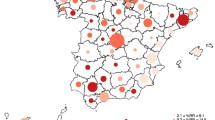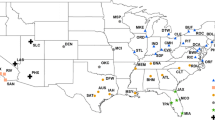Abstract
During the last few years great attention has been paid to the evaluation of the impact of extreme temperatures on human health. This paper examines the effect of extreme winter temperature on mortality in Madrid for people older than 65, using ARIMA and GAM models. Data correspond to 1,815 winter days over the period 1986–1997, during which time a total of 133,000 deaths occurred. The daily maximum temperature (Tmax) was shown to be the best thermal indicator of the impact of climate on mortality. When total mortality was considered, the maximum impact occured 7–8 days after a temperature extreme; for circulatory diseases the lag was between 7 and 14 days. When respiratory causes were considered, two mortality peaks were evident at 4–5 and 11 days. When the impact of winter extreme temperatures was compared with that associated with summer extremes, it was found to occur over a longer term, and appeared to be more indirect.


Similar content being viewed by others
References
Alberdi JC, Díaz J (1997) Modelización de la mortalidad diaria en la Comunidad de Madrid (1986–1991). Gac Sanit 11:9–15
Alberdi JC, Díaz J, Montero JC, Mirón IJ (1998) Daily mortality in Madrid community 1986–1992: relationship with meteorological variables. Eur J Epidemiol 14:571–578
Alderson MR (1985) Season and mortality. Health Trends 17:87–95
Ballester F, Michelozzi P, Iñiguez C (2003) Weather, climate and public health. J Epidemiol Community Health 57:759–760
Box GEP, Jenkins GM, Reinsel C (1994) Time series analysis: forecasting and control. Prentice Hall, Englewood Cliffs
Braga AL, Zanobetti A, Schwartz J (2001) The time course of weather-related deaths. Epidemiology 12:662–667
Curreiro FC, Heiner KS, Samet JM, Zeger SL, Strug L, Patz JA (2002) Temperature and mortality in 11 cities of the eastern United States. Am J Epidemiol 155:80–87
Davis RE, Knappenberg PC, Novicoff MM, Michaels PJ (2002) Decadal changes in heat-related human mortality in the eastern United States. Clim Res 22:175–184
Díaz J, García R, Ribera P, Alberdi JC, Hernández E, Otero A (1999) Modeling of air pollution and its relationship with mortality and morbidity in Madrid, Spain. Int Arch Occup Environ Health 75:163–170
Díaz J, López C, Alberdi JC, Jordan A, García R, Hernández E, Otero A (2002a) Heat waves in Madrid, 1986–1997: effects on the health of the elderly. Int Arch Occup Environ Health 72:366–376
Díaz J, García R, Velázquez de Castro F, Hernández E, López C, Otero A (2002b) Effects of extremely hot days on people older than 65 years in (Seville) Spain from 1986 to 1997. Int J Biometeorol 46:145–149
Dominici F, McDermot A, Zeger SL, Samet JM (2002) On the use of generalised additive models in time-series of air pollution and health. Am J Epidemiol 156:193–203
Eurowinter Group, Donaldson GC, Keatinge WR (1997) Cold exposure and winter mortality from ischaemic heart disease, cerebrovascular disease, respiratory disease, and all causes in warm and cold regions of Europe. Lancet 349:1341–1346
Hajat S, Haines A (2002) Associations of cold temperatures with GP consultations for respiratory and cardiovascular diseases amongst the elderly in London. Int J Epidemiol 31:825–830
Havenit G (2002) Interaction of clothing and thermoregulation. Exog Dermatol 1:221–268
Huynen MM, Martens P, Scram D et al (2001) The impact of heat waves and cold spells on mortality rates in Dutch population. Environ Health Perspect 109:463–470
Jendritzky G, Bucher K, Laschewski G, Walther H (2000) Atmospheric heat exchange of the human being, bioclimatic assessments, mortality and thermal stress. Int J Circumpolar Health 59:222–227
Keating WR, Donaldson GC (1995) Cardiovascular mortality in winter. Arctic Med Res 54:16–18
Kelsall JE, Samet JM, Zeger SL, Xu J (1997) Air pollution and mortality in Philadelphia, 1974–1988. Am J Epidemiol 146:750–762
Kuhn L, Davidson LL, Durkin MS (1994) Use of Poisson and time series analysis for detecting changes over times in rates of child injury following a prevention programme. Am J Epidemiol 140:943–955
Makridakis S, Wheelwright SC, McGee VE (1983) Forecasting methods and applications. Wiley and Sons, San Francisco
Martín B (2002) Días de frío extremo en Madrid. Unpublished Trabajo Académicamente Dirigido. Universidad Complutense, Madrid
McGeehin MA, Mirabelli M (2001) The potential impacts of climate variability and change on temperature-related morbidity and mortality in the United States. Environ Health Perspect 109 [Suppl 2]:185–189
Pan W, Li L, Tsai M (1995) Temperature extremes and mortality from coronary heart disease and cerebral infarctions in elderly Chinese. Lancet 345:353–355
Prieto L, García R, Díaz J, Hernández E, Teso T (2002) NAO influence on extreme winter temperatures in Madrid (Spain). Ann Geophys 20:1–9
Thakur CP, Anand MP, Shahi MP (1987) Cold weather and myocardial infarction. Int J Cardiol 16:19–25
Tobías A, Díaz J, Sáez M, Alberdi JC (2001) Use of Poisson regression and Box-Jenkins models to evaluate the short-term effects of environmental noise levels on daily emergency admissions in Madrid, Spain. Eur J Epidemiol 17:765–771
WHO (2004) Health and global environmental change. Heat waves: risks and responses. Series no. 2. World Health Organisation, Regional Office for Europe. Denmark
Acknowledgements
The authors wish to thank three anonymous reviewers for their helpful comments. The Consejería de Economía y Hacienda, Ayuntamiento de Madrid and Instituto Nacional de Metorología provided the data. The authors gratefully acknowledge the support of this study to the RCESP (Red de Centros de Investigación Cooperativa en Epidemiología y Salud Pública) UAM/CUSP.
Author information
Authors and Affiliations
Corresponding author
Rights and permissions
About this article
Cite this article
Díaz, J., García, R., López, C. et al. Mortality impact of extreme winter temperatures. Int J Biometeorol 49, 179–183 (2005). https://doi.org/10.1007/s00484-004-0224-4
Received:
Revised:
Accepted:
Published:
Issue Date:
DOI: https://doi.org/10.1007/s00484-004-0224-4




